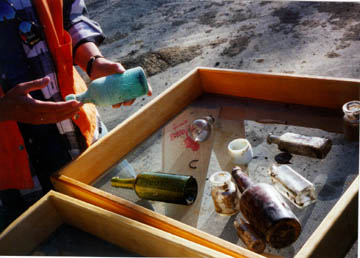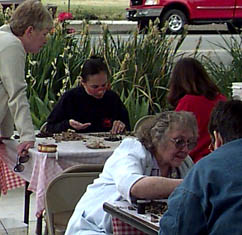A Woolen Mills Chinatown Archaeologist’s Journal -5
By Rebecca Allen, Ph.D.
Week of May 24, 1999: Fieldwork Wraps Up
Our excavation of the Woolen Mills Chinatown finished this week. Archaeologists finished the hand excavation, the backhoe directed by Anmarie Medin followed out the sewer and water lines, and the recovered artifacts were all tagged and bagged. So what we call the data recovery portion of the project is done. The backhoe pushed all of our piles of dirt into the excavated areas. (In archaeo-lingo this is called backfilling.) The site looks much the way it did before we started – minus, of course, the vegetation, which will grow back just in time for Caltrans to re-excavate the site as it begins construction at the end of this year. Mark Hylkema, the Caltrans archaeologist that we’ve been working with, was pleased to see the successful completion of the fieldwork, although that means now he has to go back to the office.
But, as I noted at the beginning of this journal, fieldwork is really just the start for us. We have all of the laboratory work to do. Then we begin writing up our findings, and interpreting the site. Anmarie is back in the office typing up all of our field notes, in close consultation with Julia Costello, and Scott Baxter is finishing up the cleaning and organizing of the artifacts. (As for me, I’m on vacation for a little bit.)

Local beverage bottles indicate commerce outside of the Chinese community. Photograph by Irene Rutledge.

Sherds of bamboo ware and other pottery, medicine vials, a marble. Photograph by Irene Rutledge.
Artifact Washing and Sorting Parties
We were helped out tremendously by volunteers from the Guadalupe River Parks and Gardens Association (GRPG) and the CHCP. Archaeologist Gina George organized all the artifacts, volunteers, and other archaeologists into washing and sorting parties. After the artifacts were wet-screened to remove all dirt and stones, they were laid in trays in the sun to dry. Gina piled the artifacts into the center of the table, and our very patient volunteers sorted out the “keepers” from the remaining dirt and small stones.
This means picking out dime to quarter size fragments of animal bone, shellfish, metal fragments, broken ceramics, and glass. Occasionally the pieces were bigger, making the task more visually interesting anyway. While these small fragments may not look like much, together they help us form a picture of what daily life was like in the Woolen Mills Chinatown – what the residents were eating, eating from, importing, and buying locally.

GRPG and CHCP volunteers pick out small pieces of ceramic and glass. Photographs by Scott Baxter.

Thanks to all the volunteers. They contributed many hours of labor, saving us a great deal of time, but also helping us move on to the interpretation of the artifacts, which is really what we’re after.
Back to the “Roasting Kettle”
The brick feature called a “roasting kettle” on a historic map proved to be one of the most intact and interesting features of the site. As Bryan Mischke further excavated the feature, a several-course round structure that was fed by a gas pipe appeared. Next to it was a rectangular brick structure, although the relationship between the two wasn’t always clear. Anmarie Medin is writing a summary of this feature, along with photographs taken after Bryan was all finished. Look for her description next week.
Reports from the lab and artifact photographs will be next on this website. We will also be summarizing and interpreting what we found during the fieldwork.
Back to (Journal -1) Week of April 26, 1999: Is Archaeology Glamorous?
Back to (Journal -2) Week of May 3, 1999: Surprises and Ceramics
Back to (Journal -3) Week of May 10, 1999: Field Photos
Back to (Journal -4) Week of May 17, 1999: Uncovering a Sense of Place and Space
Forward to (Journal -6) Week of June 7, 1999: Roasting Kettle?
Working with Caltrans are archaeological consultants from the firms of Past Forward, Inc., KEA Environmental, Inc., Foothill Resources, Inc., PAR Environmental, Inc., and the University of California, Chico.

